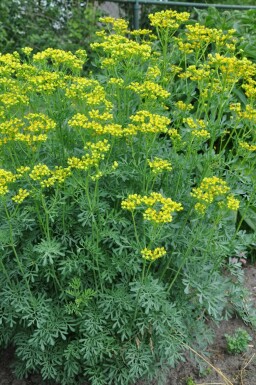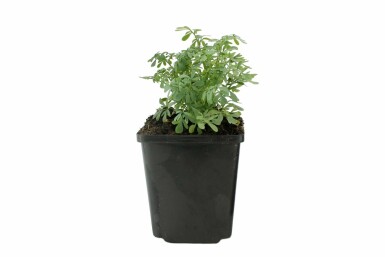

80cm



Updated on 10 September 2025
We regret to inform you that we are currently unable to ship orders to the United Kingdom. We anticipate being able to resume shipments at the beginning of 2026.
Ruta offers aromatic foliage and is drought tolerant, making it ideal for herb gardens and fragrant borders. Its grey leaves and small yellow flowers add visual interest, while its medicinal reputation provides added value. Perfect for warm gardens and natural environments.


80cm



Ruta is a fascinating addition to any garden, offering unique characteristics and multiple uses. This half-shrub features blue-green aromatic leaves and striking yellow flowers in umbrella-shaped clusters from June to August. Besides its visual appeal, Ruta holds a special place in herb gardens and fragrant borders. Its aromatic qualities attract bees, adding life to the garden. Curious about its medicinal properties or how it fits into a traditional cottage herb garden? With a history rooted in traditional medicine, this evergreen shrub promises to enrich your gardening experience. Explore the world of Ruta and discover its potential for your space.
Ruta, also known as rue or herb-of-grace, is a unique plant from the family Rutaceae. It is often called Ruta graveolens, a bitter aromatic herb. This plant is native to Southern Europe and is known for its aromatic and bitter foliage. In gardens, Ruta is used for borders, group planting, and herb gardens. The plant's flowers attract bees, making it valuable for natural gardens and insect corners. Ruta's aromatic foliage plays a role in traditional medicine. Pearlwort, another term for Ruta, has been used in various cultural rituals. The Latin name ruta symbolises repentance and has been used for purification in both Christian and pagan rituals. This plant's ecological role includes offering habitats for bees due to its aromatic flowers. Ruta is deciduous to semi-evergreen, moderately hardy, and drought-tolerant. It grows best on calcareous soil, often found in traditional cottage gardens. With its multiple uses and cultural significance, Ruta, or rue, remains a popular choice for gardeners. Whether looking to enhance a bee-friendly garden or create a traditional herb collection, buy Ruta plants in the UK for an addition to any garden space.
The development of Ruta involves a slow growth process, starting from its initial sprouting phase until it reaches a mature, shrubby form. The plant blooms from June through August, favouring warm and sunny conditions to encourage flowering. Proper care, including adequate sunlight and well-drained soil, ensures a robust flowering period.
Ruta's signature yellow and yellow-green flowers appear in umbrella-shaped clusters. These blooms are not only visually appealing but also attract bees, contributing to the biodiversity of the garden. The plant’s flowering can be influenced by its age, the type of soil it is planted in, and the prevailing climate.
Although Ruta is known for its aromatic foliage, it is the yellow flowers that draw the most attention during the blooming months. The plant's scent is intensified by warm temperatures and proper maintenance, enhancing its role as an ornamental and medicinal plant. With its compact form and aromatic leaves, Ruta remains a versatile choice for gardeners seeking to cultivate an evergreen shrub with a unique scent profile.
Ruta features unique pinnate leaves that are finely divided and boast a blue-green to grey-green hue. The silvery sheen of the leaves adds a striking appeal to any garden. These leaves are aromatic, which helps deter browsing animals. In winter, Ruta does not lose its leaves completely, as it is moderately hardy and can withstand temperatures from -18°C to -12°C. However, in severe frost or strong winds, some leaf drop can occur. Its ability to thrive in USDA zones 6 to 8 is influenced by factors like soil dryness and protection from harsh weather conditions.
Ruta is not evergreen, yet it retains much of its foliage through the colder months. The choice of planting location and local climate play a significant role in its seasonal appearance. When it comes to heat resistance, Ruta is quite robust. Originating from regions with dry climates, its leaves exhibit a tough structure and possibly a protective wax layer, aiding in water retention. Its deep root system makes it resilient during periods of drought.
Though Ruta contains essential oils that can be irritating, it is generally safe for garden use if contact with skin is avoided. It is advisable to keep this plant out of reach of children and pets due to its potential toxicity when ingested. Ecologically, Ruta provides ecological value through its aromatic foliage and small yellow flowers, which bloom from June to August. These flowers can support local biodiversity by offering nectar and habitat for insects.
Ruta, a versatile plant, can be a valuable addition to any garden. Known for its aromatic qualities, Ruta offers several practical applications in outdoor spaces. Here are some ways to make the most of Ruta in your garden:
Ruta's versatility and aroma make it a worthwhile choice for garden enthusiasts. Don't forget to explore the potential of its use in herbal beds or as a low hedge. Consider adding Ruta to your outdoor space today to enjoy its unique qualities. For those interested in adding other plants like pearlwort, buying pearlwort can complement Rue in creating a diverse and interesting garden environment.
Ruta can be a standout feature in a herb garden or rock garden. Its silvery foliage pairs beautifully with different plant families to create stunning contrasts. Consider combining Ruta with Lavandula, which complements its silvery leaves. The purple flowers of Lavandula provide a lovely contrast and attract bees, enhancing the biodiversity in the garden. Another great companion is Thymus. Its low-growing habit contrasts well against Ruta’s upright form. For a fragrant border, Santolina’s yellow flowers create a vibrant display when planted near Ruta. Rosmarinus, with its dark green foliage, offers a different texture and evergreen quality that complements Ruta’s unique appearance. These combinations are not just visually appealing but also practical. Ruta’s silvery leaves reflect sunlight, making it ideal for hot, sunny spots, where it thrives alongside Mediterranean plants. Rue is fragrant and has medicinal uses as a classic Mediterranean plant. The fragrance of Ruta enhances the aromatic qualities of nearby herbs like Origanum, creating a pleasant sensory experience. By choosing companion plants wisely, the garden can be both beautiful and functional year-round.
Ruta prefers sunny positions with at least six hours of sunlight each day. The plant thrives in well-drained, calcareous, and stony soil, which supports its growth. Although moderately hardy, Ruta is wind-sensitive, so providing a windbreak can help protect it. Soil quality is crucial; a dry, stony environment suits Ruta best. Regular fertilisation improves growth, and good drainage is essential to prevent waterlogging. Ruta is drought-tolerant and does not require constant moisture, making it ideal for dry climates. However, monitoring soil moisture can ensure optimal conditions. The preferred pH level is neutral to slightly alkaline, which influences nutrient availability and plant health. Maintaining these conditions is key for Ruta graveolens to flourish, providing a valuable addition to traditional cottage gardens. Seek out aromatic herb varieties in the UK to enhance the garden's appeal.
Planting Ruta is best done in spring, ideally from April to May, and preferably in dry weather. Pots can be planted year-round, except during frost. Those with roots or a root ball are best planted in spring or autumn. Consider the Ruta plant's distance carefully. Factors like plant type, initial size, and growth speed dictate spacing. Information on the number of plants per metre is available on the Heijnen product page. Proper soil preparation is key. Use calcareous, dry, well-drained soil. Avoid wet or heavy soils. Heijnen planting soil is recommended. Ruta thrives in sunny spots with neutral to slightly alkaline soil. Aim for at least six hours of sunlight daily. After planting, give Ruta ample water and fertilise as needed. Keep in mind its aromatic leaves are generally resistant to browsing. Whether you're growing this aromatic herb or considering its use in traditional medicine, the right conditions will ensure a flourishing garden. Pearlwort, a related species, also benefits from similar growing conditions. Ruta's medicinal and fragrant qualities make it a great addition to any herb garden or rockery.
Ruta, known for its aromatic nature, thrives in the garden with proper care. This deciduous to semi-evergreen plant is moderately hardy and drought-tolerant, making it suitable for various garden settings. For those looking to buy pearlwort, understanding the care routine is essential to maintain its health and charm.
Ruta is known for its unique appeal in the garden. The plant boasts small, beautiful yellow flowers that add a vibrant touch to any setting. Its foliage is striking with a blue-green to grey-green hue, often described as silvery. This aromatic herb has a distinctive scent, making it an excellent choice for fragrant borders. The leaves of Ruta are not only appealing to the eye but are also aromatic, contributing to the plant's overall sensory experience. As a drought-tolerant plant, Ruta thrives in warm gardens, adding ornamental value. The compact bushy growth form provides structure and texture, standing out in herb gardens and rockeries. Ruta is an aromatic patio and balcony plant with a strong scent. This plant serves as an attractive ornamental in herb borders, and its medicinal reputation adds to its appeal. Ruta is a valued bee plant, offering nourishment for pollinators. The plant's grey aromatic foliage maintains its beauty even in challenging conditions, making it an excellent addition to any garden. Rue, known as a pearlwort, is perfect for those seeking an evergreen shrub with traditional uses.
Ruta, commonly known as rue, is an aromatic herb that has found its place in traditional cottage herb gardens across the UK. Known for its distinctive bitter foliage and unique aroma, rue is a popular choice among gardeners who appreciate its ornamental and practical uses. With its ability to attract bees and produce blooms from June to August, rue offers both aesthetic and ecological benefits.
Ruta is a unique addition to any garden with its distinctive qualities.
Advantages:
Disadvantages:
Proper soil preparation, choice of location, and attentive care can reduce the risk of diseases and pests. Ensuring regular maintenance will promote the best growth and blooming of the plants.
Ruta, a valued plant with a rich medicinal history, is perfect for adding charm to any garden. Known for its bitter foliage and aromatic presence, Ruta is a great addition to herb gardens and fragrant borders. The drought-tolerant nature of this plant makes it well-suited for warm gardens, and its ornamental features are ideal for rock gardens. Ruta blooms from June to August, attracting bees with its unique flowers. When considering a purchase, Heijnen offers high-quality Ruta plants in the UK, ensuring your garden gains a truly traditional cottage herb. The medicinal reputation of Ruta enhances its appeal, providing not just beauty but also historical significance. Pair Ruta with other aromatic plants for a delightful sensory experience. With pearlwort as a companion, Ruta thrives, offering both a visual and olfactory delight. It's important to note the toxicity of Ruta, so handle with care. Buy the characterful Ruta (Rue) from Heijnen and enrich your garden with a fragrant plant rich in medicinal history.
We would like to provide some tips on how to plant and care for a Ruta. By following these tips, you can be sure to enjoy your Ruta for a long time.
Ruta thrives in sunny and well-drained locations. A spot with full sun, providing at least 6 hours of light daily, is ideal. It prefers neutral to slightly alkaline soil, particularly calcareous and dry soil. Good drainage is crucial as it tolerates drought and poor soils. Placed in the right location, Ruta rewards with better growth, vibrant foliage, and enhanced resilience. Stony and dry soils are best, and it can be grown in herb gardens, fragrant borders, and rock gardens. Additionally, Ruta suits planters, pots, and natural gardens. It's best planted in spring, ensuring dry weather conditions. Proper placement is essential for Ruta's health and flowering, leading to a vigorous and aromatic plant. Remember, moderate hardiness allows it to thrive even in less-than-ideal conditions but avoid waterlogged areas.
Before planting Ruta, it's crucial to prepare the soil properly. This involves loosening the calcareous, dry earth and mixing it well with organic matter like compost. Proper soil preparation ensures good water drainage and nutrient availability, vital for plant growth. Once the ground is ready, planting can begin. Pot-grown Ruta can be planted year-round, except during frost periods. For ball-rooted plants, spring or autumn is ideal, and it's essential to plant them with the jute sack intact. After planting, watering is important until roots establish. The size of the Ruta at planting time will determine how many can be placed per square metre in the garden. Pearlwort benefits from the same careful soil preparation to thrive. Always ensure Ruta is given a sunny spot, as it prefers at least six hours of sun daily.
Fertilising Ruta is important for healthy growth and vibrant blooms. Proper fertilisation helps maintain vitality and ensures the plant thrives. Use an organic fertiliser from Heijnen for the best results. These fertilisers support good growth, rich blooms, and overall plant health. Apply fertiliser twice a year, once in spring and again in summer to keep Ruta in top condition. The amount of fertiliser depends on the plant's size; larger plants need more. Fertiliser is absorbed when it is dissolved in the soil by water. During dry periods, water the garden after applying fertiliser to release nutrients into the soil, allowing roots to absorb them effectively. Growing Ruta in a well-nourished environment promotes the best development and enhances the beauty of your garden. Pearlwort can also benefit from this approach, ensuring both plants flourish.
Ruta requires pruning to maintain its shape and encourage healthy growth. Light pruning is ideal after blooming. It helps remove dead branches and strengthens the plant. Pruning offers benefits like promoting new growth and improving the plant's appearance. The best time to prune Ruta is in spring. This period allows for better maintenance and encourages blooming. It's essential to prune annually to keep the plant healthy and vibrant. Use sharp secateurs for precise cuts. Good tools make a difference, ensuring clean cuts and reducing damage to the plant. Always wear gloves when handling Ruta to prevent skin irritation. The best advice is to focus on removing dead or weak branches, which helps the plant flourish. Replacing leaves after 3-4 years keeps Ruta robust, especially in a calcareous, dry, sunny spot.
Ruta plants have low water requirements and thrive in dry, calcareous soil. It's crucial to water newly planted Ruta regularly to help them establish roots. Once these plants are well-rooted, they only need watering during prolonged dry periods. When watering is necessary, giving a generous amount of water less frequently is better than a little every day. The best time to water is early morning or late afternoon to reduce evaporation. Check the soil to ensure Ruta really needs water, as excess water should always be able to drain away. This applies to both in-ground and potted plants. Drip lines are effective once Ruta is fully established, but they should be combined with regular watering during the early stages. Ruta is highly drought-tolerant and adapted to dry conditions, making it a resilient choice for gardens. Pearlwort can benefit from similar care practices.
Ruta is a unique plant with grey aromatic leaves and small yellow flowers. It's often used in rituals for its association with purification and repentance. This plant adds beauty to herb gardens and thrives in warm, dry conditions. With its reputation for medicinal properties, Ruta is valued for more than just its appearance. However, care is needed as its essential oil can irritate the skin. Pearlwort can also be an excellent companion plant in gardens.
Ruta, a versatile garden plant, benefits greatly from dividing. This process allows the plant to rejuvenate, keeping it healthy and vigorous. Dividing also removes old parts and encourages new growth. The advantages of division include increased plant vitality and more Ruta plants for the garden. To divide Ruta, carefully dig up the plant, remove any old sections, and replant the young parts. It is recommended to do this every few years in early spring. Division is best done in spring for optimal growth. Use a sharp spade or garden fork for best results. Besides division, taking cuttings is another method to propagate Ruta. These techniques help maintain a thriving garden.
Pearlwort, known for its aromatic foliage and medicinal reputation, is a hardy addition to any garden. This drought-tolerant plant features compact bushy growth with blue-green leaves and small yellow flowers. Ideal for herb gardens and fragrant borders, it attracts bees and supports biodiversity. Buy Ruta (pearlwort) from Heijnen to enrich your garden with its unique charm and historical significance in traditional medicine.
